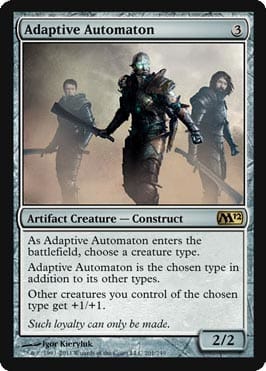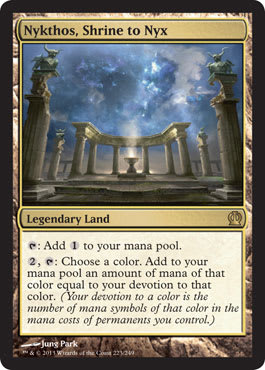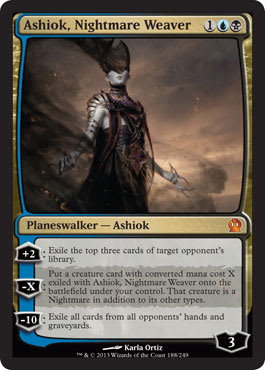Last week, I talked about theory-crafting and how to approach looking at a new format from your own eyes. This week, I had originally planned on continuing in that vein, but after testing for the past week, it has become more obvious to me that I would be better to cover the other side of that coin. Working with tried-and-tested decks can provide a great deal of support while looking for a tournament deck, as many times, the shell you pick up is already tuned to some extent and has perhaps dismissed through testing cards you originally intended to support.
When I first began playing Constructed Magic in any serious capacity, I, like many others, choose to look at Constructed as an open well of unlimited possibility in which every card deserves a look, and the more enjoyable the deck to wield, the more likely I am to pick it up. This is a fine way to begin your tournament life, and in fact, it will teach you a great number of lessons you would otherwise be void of if you moved straight into picking up lists.
Figuring out key components to a deck, such as how to build a mana base or why you need a reasonable curve, are lessons we all take for granted but fail to see why new players cannot understand. Deck-building can teach us both of these skills and more, as leaving some of the more difficult tasks for later is not always a negative.
Once you have finally proven yourself as a decent deck-builder, it is not uncommon to find playing proven decks as a bore to be replaced with your own creativity. Unfortunately, in some regard, this is the part of the beast you must slay to further yourself as a competitive player. If this mentality still drives the way you play tournament Magic, I encourage you to eventually force yourself into situations in which you play tier-one decks when they look enjoyable. This will both get you used to your comfortable style of play and teach you what you, personally, can do with a tuned deck. Many players I have seen play Magic both refused to give up this mentality and attempted to reach the higher echelons of tournament play—that is unlikely to work, as, eventually, such a person’s frustration gives way, and he or she either leaves the tournament scene or adapts.
So, of course, this all seems rudimentary enough for those looking toward this current Standard, so let us take a look at exactly what I am to compete with this weekend at what will probably be the last ever Pro Tour Qualifier in my area. I began with a Temur monsters build that I really enjoyed, but after losing to the new R/W deck, which I will cover in a moment, I also found the mana to be an issue, so I moved forward.
From there, I wanted to still be on something fast, so I looked toward the Affinity deck that has been showing up mostly online. This deck can have some nearly unbeatable draws, and it also can have some draws that beat itself—the variance was too much for me. I struggled to find something at that tier 1.5 level that I was comfortable with all the while receiving the stare-down from Heroic as I tested all week. Of course, I have the option to audible to Heroic if need be, but that seems less than ideal in the current metagame, so after testing with Raymond Perez this week, and after testing what I could on Magic Online, I finally gave in and picked up mono-green splashing red.
G/r Devotion ? Fate Reforged Standard | Robert Berni, StarCityGames Open Houston, First Place
- Creatures (31)
- 1 Boon Satyr
- 2 Genesis Hydra
- 4 Courser of Kruphix
- 4 Eidolon of Blossoms
- 4 Elvish Mystic
- 4 Sylvan Caryatid
- 4 Voyaging Satyr
- 4 Whisperwood Elemental
- 4 Polukranos, World Eater
- Planeswalkers (2)
- 2 Ugin, the Spirit Dragon
- Spells (4)
- 4 Crater's Claws
- Lands (23)
- 1 Mountain
- 10 Forest
- 4 Temple of Abandon
- 4 Wooded Foothills
- 4 Nykthos, Shrine to Nyx
- Sideboard (15)
- 2 Genesis Hydra
- 3 Nissa, Worldwaker
- 2 Setessan Tactics
- 1 Xenagos, God of Revels
- 3 Nylea's Disciple
- 2 Arbor Colossus
- 2 Reclamation Sage
So, after looking down this list, I made a few minor changes and started playing some games against R/W. Of all of the decks I have already picked up, this is probably the one I dropped the quickest. The deck is very consistent at what it does—that is not the issue. The problem I feel lies more in the matchups and how they play out against both U/B Control and R/W. The control matchup felt winnable to be sure, but after sideboarding, losing all of my small-mana guys only to be two-for-one’d over and over again was just not a game of Magic I wanted to play more than I had to.
Mono-Green Devotion, or G/r, seems to also struggle with keeping tempo in the match versus R/W, and that really just turned me off to the deck. Both matches are winnable, and I feel if I put the time and testing into Devotion, I could learn them well enough to win the majority of games. If this were my mentality, I decided it best, however, to instead just take one of the decks I had already known to have good matches against G/r and just play one of them.
Before I move on, I do want to note that this deck has been doing exceedingly well and will probably continue to at least exist within the metagame for as long as Nykthos, Shrine to Nyx is legal. Picking up any card in this deck is probably safe. If you are looking toward building one deck for most of the season, this should be the one. I do not feel that I have proper time to test this in order to find the shell I like, but if you do, this will consistently be able to ride the sheer power it can ramp into to strong finishes.
Xenagos, God of Revels and Whisperwood Elemental are both on my radar to pick up in the coming weeks. This deck is still relatively young, as is the new format, and I don’t believe people have truly taken to how many different directions this deck can be taken. Mono-Green has been unique in that the splashes are relatively easy to pull off, and each color can provide its own benefits—this makes for the potential to have multiple decks with the same shell sporting different lists, thus driving the demand up on the core staples even further. There are many cards in the deck to look to when picking up cards in both trade and cash, but these two seem relatively low-key so far, with little to no movement.
So, after Mono-Green, I moved onto R/W. This was my first time playing a tempo-burn deck since the original Jeskai shell was introduced last season, so it took me a minute to get in line with. Once I figured out some of the tighter plays, I built the deck on Magic Online and spent a few days testing there. I really do like the way this deck feels, and I can certainly see myself playing this through a PTQ, which is another important factor when deciding a deck.
R/W Aggro ? Fate Reforged Standard | Jason Blackmor, Fifth through Eighth, StarCityGames Open Houston
- Creatures (15)
- 1 Soulfire Grand Master
- 4 Goblin Rabblemaster
- 4 Seeker of the Way
- 4 Stormbreath Dragon
- 2 Brimaz, King of Oreskos
- Planeswalkers (2)
- 2 Chandra, Pyromaster
- Spells (19)
- 2 Wild Slash
- 3 Lightning Strike
- 4 Stoke the Flames
- 4 Hordeling Outburst
- 2 Outpost Siege
- 4 Chained to the Rocks
- Lands (24)
- 10 Mountain
- 4 Plains
- 1 Evolving Wilds
- 1 Wind-Scarred Crag
- 4 Battlefield Forge
- 4 Temple of Triumph
- Sideboard (15)
- 1 Abzan Advantage
- 2 Valorous Stance
- 2 Sarkhan, the Dragonspeaker
- 2 Hushwing Gryff
- 1 Scouring Sands
- 3 Glare of Heresy
- 1 Circle of Flame
- 1 Erase
- 2 Arc Lightning
I was not playing this exact shell during testing, but all of the same components are there. This deck looked far worse to me a few weeks ago when I first saw it than it does after testing. I figured this would be quickly eclipsed much in the way Jeskai was by Abzan since it can easily prey on these types of decks. The reality of this format is that Abzan—luckily for this deck—is poorly positioned right now. While I think this deck will continue to be a factor in the format, I expect its popularity to die off in the coming month, when people find a new way to approach the format.
I am very comfortable playing this deck, and though I would happily sleeve it up for this weekend, I have managed to be swayed once again by testing—to the point that I finally believe I will rest this weekend. Before I move on, I believe it is important to note that many of the cards from this deck will be inflated in the coming weeks, and similar to what we saw from cards like Mantis Rider last time, it would be best to move them within this window in order to avoid holding the goods when this deck falls from favor.
So how did I go from playing a midrange Temur deck, through all of this, and end up on a deck I am probably the least comfortable with? Testing: Plain and simple, playing games of Magic is how I learn. Some people are naturally gifted at this game or able to theory-craft masterpieces to take over major events, but I am not among them, and with my return to Magic this past season, it is a fault I am finally willing to overcome. I, as with many players, have to realize that if I want to win an event, I need to learn to play anything the format calls for. This is not to say you cannot have a preference or learn toward one deck over another. I posted a list last week of U/B control, and though I will spare you the bore of reading the deck again, it has certainly shown to be both consistent and capable of dealing with the other two decks mentioned above.
Control is always a scary animal to tame because, most of the time, you really have to tune the deck to the expected metagame, as the field is far too diverse to cover everything in your seventy-five. This will usually be rewarded with some early wins, as you can set your mind to rest about running into untested matchups, but if you snag an early loss, your run can quickly be over. I am taking this deck this weekend because I feel confident I can Top 8 a PTQ size event, something I have done multiple times. The pressure does not get to me, and I do not play looser when at the higher tables—which are all actual concerns when you first break into competitive Magic. This is not to say I will Top 8, but I believe myself equally capable of anyone in the room, and given that mentality, I want to play a deck that can close the tournament against the other top-tier decks. Sure, there is the chance I crash and burn playing some unknown archetype in the first few rounds, but I feel I would rather take that chance than be ill-equipped to win the finals of such a major event.
As I have more testing to get back to, I leave you all for the week in what I hope are high spirits. I know I am both exhausted and exhilarated for this coming weekend and for the grueling rounds I am sure Control will provide. I will fill you in on how I do next week as well as talk about some of the other lessons I may have learned from this weekend’s PTQ in Michigan. If you will be there, come find me—I hope to be among the top tables!
Ryan Bushard


























